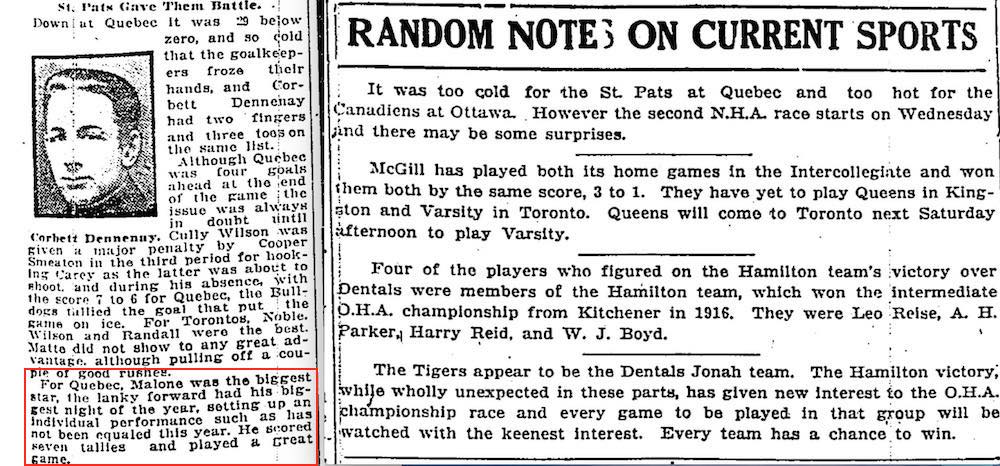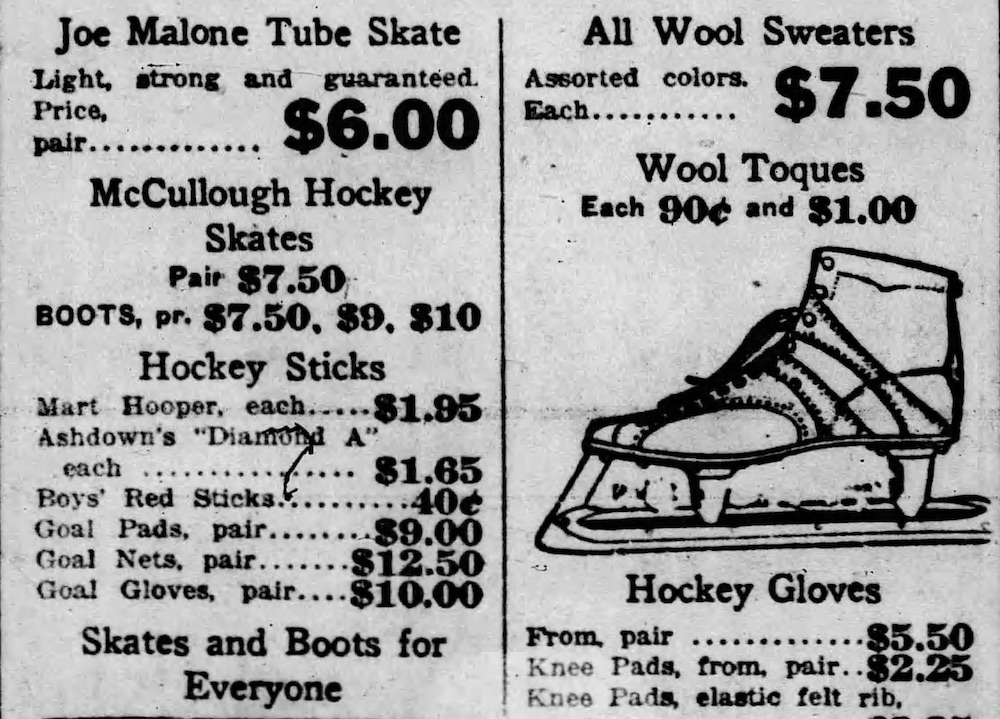The first story of the new year and back to a familiar old subject. I haven’t been watching much hockey lately (though I’m expecting a new writing assignment soon), but with tomorrow marking the 100th anniversary of the oldest major NHL record still on the books, I felt that I’d no longer have the right to call myself a hockey historian if I didn’t chime in on this. So here we go…
On January 31, 1920 (I have a hard time accepting that 1920 is 100 years ago!), Joe Malone of the Quebec Bulldogs scored seven goals in a 10-6 win over the Toronto St. Pats. (Some will tell you the Bulldogs should actually be the Quebec Athletics that season, but let’s not argue about that here.)

Because those seven goals are still a single-game NHL record, and because he led the league with 44 goals in just 20 games in the NHL’s first season of 1917-18 (a record that wasn’t broken until Maurice Richard scored 50 goals in 50 games in 1944-45), Joe Malone is one of the only names that many people recognize from hockey’s early days. I could argue that there are others from his era that were actually better players, but there’s no denying that Malone was a gifted goal-scorer. He was a skilled stickhandler known as Phantom Joe – likely for his ghost-like ability to weave his way through his opponents – and also played a clean game in an era that was incredibly rough.
So, given that one of the greatest players of his day set a record that would stand for 100 years, you’d think it was probably a pretty big deal at the time. Well, you’d be wrong! Malone’s seven-goal game got very little coverage in the newspapers of the day. There are several reasons why.

As I wrote in a story about Joe Malone for The Hockey News on the 90th anniversary 10 years ago, first and foremost as to why the record drew so little attention was because it occurred in a meaningless midseason game – much more meaningless than most. In this era, the NHL’s four teams played a split schedule to contest their 24-game season. The top team after 12 games of the first half met the winner of the 12-game second half for the postseason champion. So on the night of January 31, 1920, a playoff spot was on the line when the 8-3 Ottawa Senators hosted the 8-3 Montreal Canadiens. Meanwhile, the 5-6 Toronto St. Pats were out of contention when they traveled to Quebec City to face Joe Malone’s woeful 1-10 Bulldogs. The results of Ottawa’s 11-3 win over Montreal attracted much more press coverage than did Malone’s seven-goal game.
Attendance at the game in Quebec would likely have been sparse anyway, but the coldest night of the winter attracted the smallest crowd of the year. Only about 1,200 fans witnessed Malone’s scoring spree. The game report in the Toronto Star stated that it was 29 degrees below zero, “so cold that the goalkeepers froze their hands, and Corbett Denneney [of the St. Pats] had two fingers and three toes on the same list.”

It was certainly cold … but the game was a hot one! Malone tested Toronto’s Ivan “Mike” Mitchell early, but the netminder kept him off the score sheet until 6:50 of the first period. It was 3-2 Quebec when the first 20 minutes ended, though Malone had nearly scored a second goal late in the frame. (If it hadn’t been called back – for reasons that are unclear – the NHL’s single-game record would be eight goals, not seven.)
Malone officially got goal number two just 55 seconds into the second period, with three and four coming later as Quebec’s lead grew to 6-4 after forty minutes. Toronto replaced Mitchell in net with Howard Lockhart for the third period, and the St. Pats pulled to within 7-6 before Cully Wilson took a major penalty. Malone scored goals number five and six while the St. Pats were shorthanded. Goal number seven came late in the game and closed out a 10-6 Bulldogs victory.
“For the locals,” stated reports of the game in most Canadian newspapers, “Joe Malone was the bright star. The lanky forward had his biggest night of the year, setting up an individual performance that has not yet been equaled this year. He scored seven tallies, and played a great game.”
That’s it.
There are several more reasons for the scant coverage.

Though sticks and skates were primitive (but no more so than the pads that goalies wore) and forward passing was only allowed in the neutral zone, high scoring performances were far from rare in hockey’s early days. Stars often played the full 60 minutes, or very close to it, so scoring opportunities were plentiful. Newsy Lalonde had scored six goals in a game for the Canadiens just three weeks earlier, and Malone would score six himself on March 10, 1920. (Brothers Corb and Cy Denneny would each have a six-goal game in 1921.)
So there was little reason to expect Malone’s record to last for 100 years. Even less so because it would have been impossible for anyone to believe that the NHL itself would last for 100 years! Leagues had come and gone fairly regularly in hockey’s early days, and the NHL was only in its third season. Fans would barely have differentiated it from its forerunner, the National Hockey Association, or from any of the other top leagues that had come before.
And Malone himself had already scored seven goals in an NHA game back in 1913. He’d topped that with eight goals in one game during that league’s final season of 1916-17. But that wasn’t Malone’s best effort either! On March 8, 1913, he scored nine goals to lead the Quebec Bulldogs to a lopsided 14-3 win over the Sydney Millionaires in a Stanley Cup game. Yet even nine goals in a Stanley Cup game wasn’t unprecedented. Many fans in 1913 and in 1920 would still have recalled that Frank McGee scored 14 goals for the Ottawa “Silver Seven” in a Stanley Cup game against Dawson City back in 1905. So what’s the big deal about scoring seven?

Still, it’s surprising to see just how little impact Malone’s seven-goal game seems to have made. It was overlooked to the point that, when Malone was elected to the Hockey Hall of Fame in 1950, a Canadian Press report pointed out that the NHL record book at that time credited Syd Howe (no relation to Gordie) as the NHL’s single-game scoring leader with a six-goal effort on February 3, 1944.
It would seem that Joe Malone’s induction into the Hall of Fame is what finally put his seven-goal game into the consciousness of the hockey public some 30 years after the fact. Having surviving now for 100 years, it will likely remain in the NHL’s (online) record book for many more years to come.
